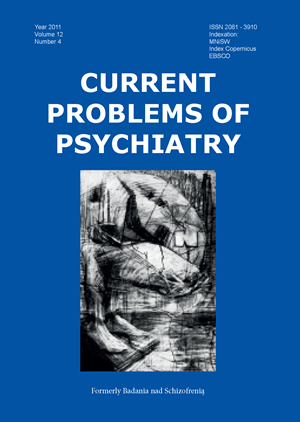Will neuroscience ever enter the courtroom?
Słowa kluczowe:
psychiatria sądowa, f MRI, neuronaukaAbstrakt
Rozwój i postępy w zakresie badań nad neurobiologicznymi uwarunkowaniami życia psychicznego i zachowania człowieka powodują pojawienie się pytań dotyczących podłoża wyborów moralnych i odpowiedzialności.
Autorzy poruszają problemy z zakresu neuronauki i prawa, poddają analizie wyniki badań nad strukturą i funkcją mózgu w wybranych stanach klinicznych, jak psychopatia, pedofilia, zachowania agresywne. Omawiane są związki pomiędzy istniejącymi anomaliami w układzie nerwowym a charakterem i rodzajem czynów przestępczych i zdolnością do zawinienia sprawców tych czynów.
Autorzy podnoszą trudności w prowadzeniu na szerszą skalę badań fMRI w psychiatrii sądowej z uwagi na koszty. Jednak podkreślają, że niektóre dane z tego typu badań bywają już używane przy orzekaniu przez sądy. Ponadto propozycje stosowania fMRI dotyczyć mogą badania symulacji, prognozy zachowań agresywnych, trwałości abstynencji.
Bibliografia
1. Birbaumer N, Ver M, Lotze M. Deficient fear conditioning in psychopathy: a functional magnetic resonance imaging study. Arch Gen Psychiatry. 2005;62:799-805.
2. Blair RJ. Neurobiological basis of psychopathy. Br J Psychiatry. 2003;182:5-7.
3. Brunner HG, Nelen M, Breakefield XO, Ropers HH, van Oost BA. Abnormal behaviour associated with a point mutation in the structural gene for monoamine oxidase A. Science. 1993;262:578-80.
4. Capsi A, Mc Clay J, Moffitt TE, Mill J, Martin J, Craig IW, et al. Role of genotype in the cycle of violence in maltreated children. Sci-ence. 2002;297:851-4.
5. Davidson RJ, Putnam KM, Larsson CL. Dysfunction in the neural circuitry of emotion regulation – a possible prelude to violence. Science. 2000;289:591-4.
6. Decety J, Jackson PL. The functional architecture of human empathy Behav Cogn Neurosci Rev. 2004;3:71-100.
7. Dressing H, Sartorius A, Meyer-Lindenberg A. Implication of fMRI and genetics for the law and routine practice of forensic psychia-try. Neurocase. 2008;14(1):7-14.
8. Farrow T. Neuroimaging of empathy, In: Farrow T, Woodruff P, editors. Empathy in mental illness. Cambridge University Press; 2007. p. 201-16.
9. Fince C, Kennett J. Mental impairment, moral understanding and criminal responsibility: psychiatry and the purposes of punish-ment. Int J Law Psychiatry. 204;27:425-43.
10. Garland B, Glimcher PW. Cognitive neuroscience and the law. Curr Opin Neurobiol. 2006;16:130-4.
11. Haidt J. The synthesis in moral psychology. Science. 2007;316:998-1002.
12. Heitzman J. Psychiatria i prawo, In: Hales RE, et al, editors. The American psychiatric publishing textbook of psychiatry. War-szawa: Medipage; 2010. p. 337-406.
13. Jacob CP, Philipsen A, Ebert D, Deckert J. [Multiodal treatment of adult attention-deficit hyperactivity disorder]. Nervenarzt. 2008;79:801-8. German.
14. Laakso MP, Gunning-Dixon F, Vaurio O, Repo-Tiihonen E, Soin-inen H, Tiihonen J. Prefrontal volumes in habitually violent sub-jects with antisocial personality disorder and type 2 alcoholism. Psychiatry Res. 2001;114:95-102.
15. Markowitsch HJ. Neuroscience and crime. Neurocase. 2008;14:1-6.
16. Mool J, de Oliviera-Souza R, Bramati JE, Grafman J. Functional networks in emotional moral and nonmoral social judgments. Neuroimage. 2001;16:696-703.
17. Minzenberg MJ, Fan J, New AS, Tang CY, Siever LJ. Fronto-limbic dysfunction in response to facial emotion in borderline personal-ity disorder: an event-related f MRI study. Psychatr Res. 2007;155:231-43.
18. Müller JL. [Forensic psychiatry in the era of neuroscience: pre-sent status and outlook for neurobiological research]. Nerve-narzt. 2009;80:241-51. German.
19. Müller JL, Sommer M, Döhnel K, Weber T, Schmidt-Wilcke T, Hajak G. Disturbed prefrontal and temporal brain dysfunction during emotion and cognition interaction in criminal psychopa-thy. Behav Sci Law. 2008;26:131-50.
20. Phelps EA, O’Connor KJ, Cunningham WA, Funayama ES, Gatenby JC, Gore JC, et al. Performance on indirect measures of race evaluation predicts amygdala activation. J Cogn Neurosci. 2002;12:729-38.
21. Raine A, Ishikawa S, Arce E, Lencz T, Knuth KH, Bihrle S, et al. Hippocampal structural asymmetry in unsuccessful psychopaths. Biol Psychiatr. 2004;55:185-91.
22. Reeves D, Mills MJ, Billick SB, Brodie JD. Limitations of brain imaging in forensic psychiatry. J Am Acad Psychiatry Law. 2003;31:89-96.
23. Rilling JK, Glenn AL, Jairam R, Pagnoni G, Goldsmith DR, Elfen-bein HA, et al. Neural correlates of social cooperation and non-cooperation as a function of psychopathy. Biol Psychiatr. 2007;61:1260-71.
24. Schanda H, Stompe T, Ortwein-Swoboda G. Dangerous or merely difficult? The new population of forensic mental hospitals. Eur Psychiatry. 2009;24:365-72.
25. Schiffer B, Peschel T, Paul T. Gizewski E, Forsting M, Leygraf N, et al. Structural brain abnormalities in the frontostriatal system and cerebellum in pedophilia. J Psychiatr Res. 2007;41:753-61.
26. Silva JA. Forensic Psychiatry, Neuroscience and the Law. J Am Acad Psychiatry Law. 2009;37:489-502.
27. Weber S, Habel U, Amunts K, Scheider F. Structural brain abnor-malities in psychopaths: a review. Behav Sci Law. 2008;26:7-28.
28. Yang Y, Raine A, Lencz T, Bihrle S, LaCasse L, Colletti P. Volume reduction in prefrontal gray matter in unsuccessful criminal psy-chopaths. Biol Psychiatry. 2005;57:1103-8.
Pobrania
Opublikowane
Numer
Dział
Licencja
Prawa autorskie (c) 2011 Autorzy

Praca jest udostępniana na licencji Creative Commons Attribution-NonCommercial-NoDerivatives 3.0 Unported License.


